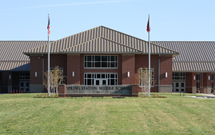
The first institution to be highlighted in our brand-new “eSchool of the Month” series is Spring Station Middle School (SSMS) in Tennessee’s Williamson County Schools. SSMS serves about 700 students in grades 6-8 and “seeks to be a leader in student integration of ed tech,” according to Assistant Principal Timothy Drinkwine.
Here, Drinkwine shares the school’s secrets to success. (SSMS will be featured in the May print edition of eSchool News. To nominate your own school or district for this award, go to http://www.eschoolnews.com/school-of-the-month.)
How does your school use technology to advance student learning?
Each and every classroom in the school building has a Dell teacher laptop and laptop dock, a Promethean ActivBoard, an ELMO document camera, and a Dell projector. Each grade level has Flip handheld video cameras and mobile computer labs on carts.
Teachers are able to move around the classroom with their mobile laptops, solicit student participation in manipulating the Promethean ActivBoard, display student work on the ELMO document camera, as well as scan student work and save it for later presentations by displaying it via the projector. All teachers incorporate Google Apps and Microsoft Office tools (Outlook, Excel, Word, Publisher, etc.) into their classes. All teachers have been exposed and trained to integrate Microsoft Photo Story, Prezi (a presentation editor), and online message boards to solicit student participation in the learning process.
Software programs such as Wilson Reading, Gaggle, and Study Island are used for various purposes to increase student learning and achievement. Math teachers use Interwrite tablets, teacher teams use clickers, and student-owned iPods are used in classrooms.
Every teacher has his or her own SharePoint site to communicate, post, and cite any information for students and parents.
Has your school noticed an increase in student performance and/or motivation as a result of this technology use? If so, how?
Student motivation and time spent on task have increased when students are able and allowed to use iPods, digital cameras, clickers, interactive whiteboards, laptops, and video cameras. When technology tools are integrated into learning at SSMS, students generally evaluate their own engagement levels at the high end of authentic engagement, compared to when the tools are taken away. With regard to student performance, we will not see a detailed growth measurement until next year; SSMS is a brand-new school as of the 2010-11 school year.
How does your school use technology to streamline school administration and aid in decision-making?
SSMS issues a laptop to every teacher so they may easily transport their work from place to place when they are lesson planning, collaborating, and/or working toward school goals. The school administration uses online message boards and Google forms and surveys to solicit feedback from faculty and staff when making school-level decisions and changes.
Has your school realized an increase in efficiency, a savings in administrative costs, a boost in staff or student performance, or some other tangible benefits as a result of this technology use? If so, how?
Efficiency has increased when it comes to feedback time. Surveys have been conducted via Google forms to solicit feedback to certain queries that influence the school at large. These are administered in an online format, answered at the responders’ leisure, and responses are placed into graphs and charts for interpretation.
Using the free Google apps helps us save in terms of administrative costs.
How has your school financed its technology initiatives—through grants? e-Rate funds? Local funds? Corporate partnerships? Or some combination of these techniques?
Local funds have launched SSMS in its inaugural year. However, with the newness wearing off, SSMS leaders are determining how to garner grant funding and local corporate partnerships in the years to come, in order to sustain and improve the technology that is already in place.
What initiative or project are you most proud of, and why?
From a professional perspective, the movement toward working in the cloud has been most satisfying so far. SSMS is working with Google Apps [and] participating in online discussion boards … to further its goal to operate in the cloud.
SSMS also is proud of its efforts to become more student-friendly to its Millennials and Generation Z by incorporating [students’] own digital devices—such as smart phones, eReaders, and tablets—into the learning process.
What have been your biggest challenges in integrating technology into classrooms and school processes, and why? How have you overcome those challenges?
Change has been the biggest challenge: an occasional faculty member and/or student who want to do things “the old way,” as well as some community members who want to stick to the past. … However, these challenges more often than not are easily combatted by proper training and education around just how valuable technology integration really is.
What’s your best or most useful ed-tech advice for your colleagues?
Keep trying different things. We live in exponential times, and the only thing that will remain the same is change itself. Because we are constantly changing, the ones who make a constant effort to keep up with change or change the framework of ed tech itself are the ones who will be the trailblazers of the 21st century.
- Educators Honored with YouScience® Innovative Educator Award - April 25, 2024
- CIESC Member Schools Gain Access to Metrasens Ultra Weapons Detection Systems Through New Partnership - April 24, 2024
- SchoolStatus Launches SchoolStatus Boost, an Innovative Educator Development Solution for Enhanced Teacher Growth and Development - April 22, 2024


